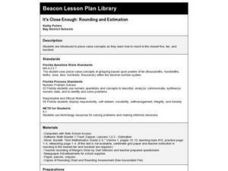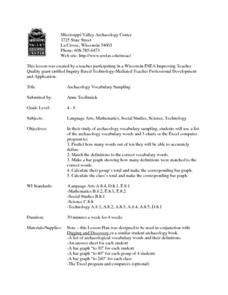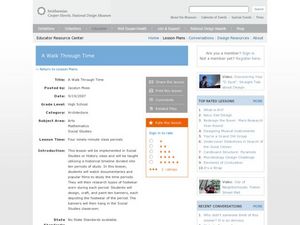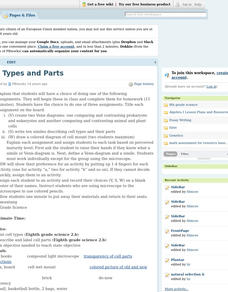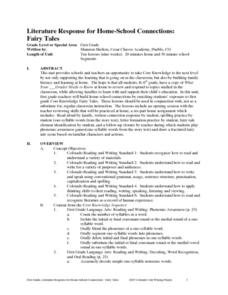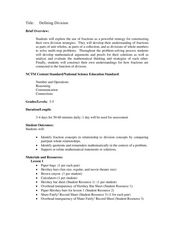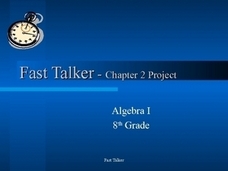Fuel the Brain
Comparing Numbers; Joining with No Regrouping
Your learners will know how solve word problems based on using coins. This skill will be important for the future so they can compare different coin values and how they add up, as well as how to join without regrouping.
Curated OER
It's Close Enough: Rounding and Estimation
Second graders round to the closest five, ten, and hundred. They use place-value concepts of grouping based upon powers of ten (thousandths, hundredths, tenths, ones, tens, hundreds, thousands) within the decimal number system.
Curated OER
Finding Addition Patterns
Students practice finding the sums of two-one digit numbers. In this addition lesson plan, students also record facts onto an addition chart.
Curated OER
Place Value
First graders practice place value by completing problems that allow them to group 10 items together to create groups of 10 and see what is left over. In this place value lesson plan, 1st graders use cups to put 10 items in them, and...
EngageNY
Exponents
Powered up! Here's a great resource on exponents. Scholars build on their previous understanding of exponents to include all positive real number bases. Distinguishing between an and a^n is a major goal in the fifth lesson of a 36-part...
Curated OER
Subtraction
First graders write and illustrate a story for a subtraction problem subtracting from the number ten. Students explore subtraction situations by using counters to represent a familiar number- based literature selection. Students role...
Curated OER
Multiplying By Whole Tens
In this multiplying worksheet, students count by tens, write the rule for multiplying by ten, and then multiply numbers by ten. Examples and explanations are given prior to the exercise. This two-page worksheet contains approximately 30...
Curated OER
Area of Parallelograms
In this area of parallelograms worksheet, 10th graders solve 8 problems that include finding the area of various parallelograms. First, they find the area of each given figure in number 1-3. Then, students find the area of each shaded...
02 x 02 Worksheets
Measuring Length
Your young forensic scientists add to and strengthen their measurement and conversion skills with these seven well-scaffold worksheets. Metric conversions, measuring length, area, and volume, reading thermometers, graduated cylinders,...
EngageNY
Adding and Subtracting Polynomials
Need a unique approach to adding and subtracting polynomials? A helpful math lesson approaches the concept by relating polynomials to base 10. It encourages pupils to see each term as having a specific value, and therefore,...
Curated OER
Rounding and Estimation
In this rounding and estimating activity, students learn how to round numbers up and down. They also read about using estimations to quickly calculate answers to difficult math problems. Students then solve the 12 rounding questions in...
EngageNY
Main Ideas in Informational Text: Analyzing a Firsthand Human Rights Account for Connections to Specific Articles of the UDHR
Lesson 10 in a series of human rights lessons focuses on the skills of finding evidence and summarizing. Your young readers work to compare the two texts they have read in this unit: the Universal Declaration of Human Rights...
Curated OER
Phrasal Verbs with Get
Students identify ten phrasal verbs with "get". In this phrasal verbs lesson, students read and analyze a conversation between two people. Students interpret the meaning of the phrases in the diaglogue. Games and additional activities...
Curated OER
Quiz: Scatter Plots and Line of Best Fit
In this scatter plots and line of best fit worksheet, students create scatter plots from given sets of data. They answer questions concerning the scatter plot. Students write the equation of a line, identify the type of correlation...
Curated OER
Archaeology Vocabulary Sampling
Learners predict how many words out of ten they accurately define. They match the definitions to the correct vocabulary words and make a bar graph showing how many definitions were matched to the correct words. The write their group...
Curated OER
A Walk Through Time
Students investigate the types of footwear worn during ten periods of history. In this secondary, art/math/social studies instructional activity, students view documentaries and popular films to study the time periods. ...
Curated OER
Death, Be Not Proud Questions
In this reading comprehension learning exercise, students respond to 5 short answer and essay questions based on Donne's "Death Be Not Proud."
Curated OER
Cells And Their Parts
High schoolers investigate different types and their parts. They differentiate prokaryote and eukaryote cells and create a venn diagram displaying differences or similarities. Students write ten similes related to the cells and parts of...
Curated OER
Literature Response for Home-School Connections:
First graders explore learning skills that can be practiced at home in the ten lessons of this unit. Oral reading, letter formation, fairy tale identification, and phonic awareness exercises are provided in this unit.
Curated OER
Defining Division
Upper graders explore division through fair-shares. They will review fair shares and fractions as a segway into division. They start by playing "Share Fairly" game and create mathematical arguments for solving problems. Manipulatives and...
Curated OER
Fast Talker - Ch 2 project
Tongue Twisters?! Create scatter plot graphs based on timing fellow classmates saying tongue twisters. Then investigate, display, and analyze the relationships based on functions. Wrap up this activity by making a...
K12 Reader
Money, Money, Everywhere!
Pennies, nickels, dimes, quarters, half-dollars, dollars. Here's a comprehension worksheet that asks young readers to respond to a series of questions based on a passage about money.
Curated OER
The Five Senses - Learning the Senses
Students learn what each sense does for the student.
Curated OER
Numbers System Conversions
For this number system conversions worksheet, students explore, analyze and develop mastery skills in converting between alternative number systems.

